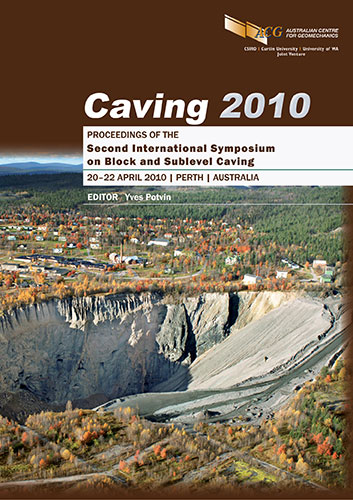Simulating the impacts of hydraulic fracture preconditioning on caveability and fragmentation at the planned Cadia East panel cave

|
Authors: Rogers, S; Elmo, D; Webb, G; Catalan, A |
DOI https://doi.org/10.36487/ACG_rep/1002_46_Rogers
Cite As:
Rogers, S, Elmo, D, Webb, G & Catalan, A 2010, 'Simulating the impacts of hydraulic fracture preconditioning on caveability and fragmentation at the planned Cadia East panel cave', in Y Potvin (ed.), Caving 2010: Proceedings of the Second International Symposium on Block and Sublevel Caving, Australian Centre for Geomechanics, Perth, pp. 663-675, https://doi.org/10.36487/ACG_rep/1002_46_Rogers
Abstract:
The caving process relies significantly on the natural fragmentation of the rock mass created by the network of fractures and faults. In order to help mitigate the risk associated with unfavourable cave propagation and fragmentation in stronger or less fractured rock masses, the use of preconditioning through hydraulic fracture (HF) generation has increasingly been used. In an attempt to provide a quantitative evaluation of the likely impact of various preconditioning strategies, a combination of discrete fracture network (DFN) and hybrid finite/discrete element method (FEM/DEM) numerical simulations have been undertaken. DFN simulations provide a means to develop an accurate description of the in situ fragmentation. The impact of preconditioning can then be included by adding to the model stress parallel HF of a certain design size and interval spacing. The resultant fragmentation resulting from both natural and induced fractures can then be determined. This can include both the full fragmentation curve as well as the proportion of the rock mass forming large residual blocks of poorly fragmented rock that represent an increased risk of oversize potential. Volumes of the rock mass prone to significant residual block formation can be identified from cave scale DFN modelling, allowing the mapping of these potentially problematic zones of the rock mass. The DFN models can be transferred to a stress analysis method to directly simulate, through synthetic rock mass testing, the impact of preconditioning on rock mass strength. By using a cave-induced stress-path history, synthetic testing of simulated rock samples with and without preconditioning provides a clear indication of the impact of preconditioning on rock mass strength and primary fragmentation. Large scale models are used for simulating cave initiation and growth using embedded DFN fracture traces, to investigate the effects of preconditioning upon caveability.
References:
Brady, B. and Brown, E.T. (1993) Rock mechanics for underground mining (2nd Edition), Chapman & Hall, p. 588.
Catalan, A., Suarez, C., Barrera, V. and Qudraturrahman, I. (2008) Cadia East Underground Project Pre-Feasibility Study, Geotechnical Report, Newcrest Mining Limited Internal Document.
Dershowitz, W., Lee, G., Geier, J. and LaPointe, P.R. (1998) FracMan: Interactive discrete feature data analysis, geometric modelling and exploration simulation, User Documentation, Golder Associates Inc., Seattle, Washington.
Dershowitz, W.S. and Carvalho, J. (1996) Key-Block Tunnel Stability Analysis using Realistic Fracture Patterns, NARMS 06.
Elmo, D., Yan, M., Stead, D. and Rogers, S. (2007) The importance of intact rock bridges in the stability of high rock slopes: Towards a quantitative investigation using an integrated numerical modelling – discrete fracture network approach, in Proceedings International Symposium on Rock Slope Stability in Open Pit Mining and Civil Engineering, Slope Stability 2007, Perth, Australia.
Elmo, D., Stead, D. and Rogers, S. (2008) A quantitative analysis of a fractured rock mass using a discrete fracture network approach: Characterisation of natural fragmentation and implications for current rock mass classification systems, in Proceedings 5th Conference and Exhibition on Mass Mining, June, Lulea, Sweden.
Golder Associates (2009) FracMan 7.20, FracMan Technology Group, Golder Associates Inc., Seattle, Washington.
Hulls, I., Smith, J. and Walton, R. (2008) Cadia East stress measurements, Coffey Mining Pty Ltd, report submitted to Newcrest Mining Limited.
Kendorski, F.S. (1978) The caveability of ore deposits, Mining Engineering, Vol. 30, pp. 628–631.
Klerck, P.A. (2000) The finite element modelling of discrete fracture in quasi-brittle materials, PhD thesis, University of Swansea, UK.
Klerck, P.A., Sellers, E.J. and Owen, D.R.J. (2004) Discrete fracture in quasi-brittle materials under compressive and tensile stress states, Computer Methods in Applied Mechanics and Engineering, Vol. 193, pp. 3035–3056.
Mahtab, M.A., Bolstad, D.D. and Kendorski, F.S. (1973) Analysis of the geometry of the fractures in San Manuel Copper Mine, Arizona, US, Bureau Mines Report, 7715.
Moffitt, K.M., Rogers, S.F., Beddoes, R.J. and Greer, S. (2007) Analysis of Slope Stability in Strong, Fractured Rock at the Diavik Diamond Mine, NWT, in Proceedings 1st Canada-U.S. Rock Mechanics Symposium, Vancouver.
Pine, R.J., Owen, D.R.J., Coggan, J.S. and Rance, J.M. (2007) A new discrete modelling approach for rock masses, Geotechnique, Vol. 57(9), pp. 757–766.
Rockfield Software (2009) ELFEN Version 4.3.3, Swansea, UK.
Rogers, S., Elmo, D., Beddoes, R. and Dershowitz, W. (2009) Mine scale DFN modelling and rapid upscaling in geomechanical simulations of large open pits, in Proceedings International Symposium on Rock Slope Stability in Open Pit Mining and Civil Engineering, Santiago, Chile.
Rogers, S., Elmo, D., Webb, G. and Catalan, A. (2010) A discrete fracture based approach to defining in situ, primary and secondary fragmentation distributions for the Cadia East panel cave project, in Proceedings 2nd International Symposium on Block and Sublevel Caving (Caving 2010), Y. Potvin (ed), 20–22 April 2010, Perth, Australia, Australian Centre for Geomechanics, Perth, pp. 425–440.
Vyazmensky, A., Elmo, D. and Stead, D. (2009) Role of Rock Mass Fabric and Faulting in the Development of Block Caving Induced Subsidence, Rock Mechanics and Rock Engineering, .
Yu, J. (1999) A contact interaction framework for numerical simulation of multi-body problems and aspects of damage and fracture for brittle materials, PhD thesis, University of Wales, Swansea, UK.
© Copyright 2025, Australian Centre for Geomechanics (ACG), The University of Western Australia. All rights reserved.
View copyright/legal information
Please direct any queries or error reports to repository-acg@uwa.edu.au
View copyright/legal information
Please direct any queries or error reports to repository-acg@uwa.edu.au